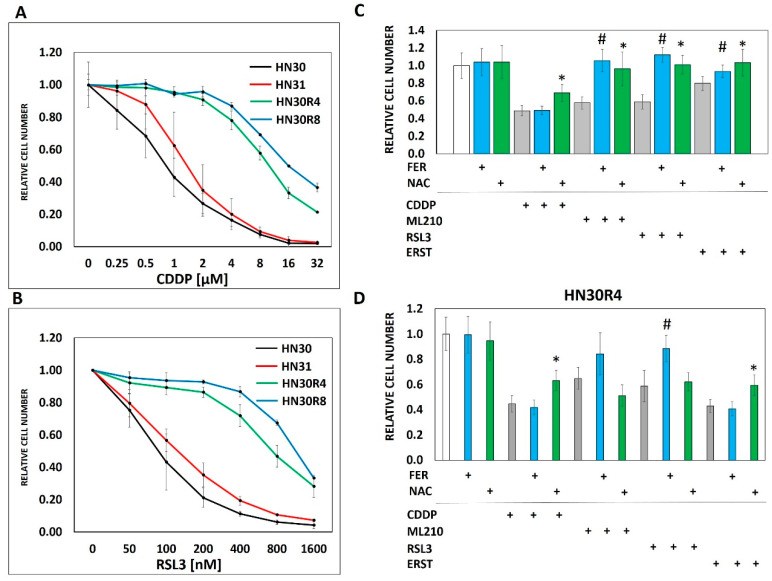Figure 2.
Conditioned cisplatin resistance generates cross-resistance to ferroptosis. (A) Exposure of HN30 cells to increasing concentrations of cisplatin (CDDP) resulted in generation of 2 resistant pooled populations (R4- cell line capable of proliferating in growth media containing 4 µM CDDP; R8- cell line capable of proliferating in growth media containing 8 µM CDDP). Both resistant pooled populations greatly surpassed the intrinsic cisplatin resistance demonstrated by HN31. (B) HN30R4 and HN30R8 demonstrated a significant decrease in sensitivity to RSL3 compared to the HN30 parental line. (C) Ferrostatin (FER) (1 μM) (blue bars) reversed the effects of RSL3, ERST and ML210 but not cisplatin on HN30 (72 h assay). NAC (3 mM) (green bars) reversed the effects of all 4 drugs (# indicates a statistically significant difference between drug alone and drug + ferrostatin using t-test, p-value <0.05; * indicates a statistically significant difference between drug alone and drug + NAC using t-test, p-value <0.05). (D) Sensitivity to both cisplatin and ferroptosis inducers was dramatically decreased in the HN30R4 pooled population compared to the parental HN30 cell line; ferrostatin (blue bars) and NAC reversal (green bars) of drug toxicity are partially abrogated (# indicates a statistically significant difference between drug alone and drug + ferrostatin using t-test, p-value <0.05; * indicates a statistically significant difference between drug alone and drug + NAC using t-test, p-value <0.05). Drug concentrations for HN30 are—CDDP 1µM, ML210 0.5 µM, RLS3 0.1 µM, ERST 2.0 µM. Drug concentrations for HN30R4 are—CDDP 16 µM, ML210 8 µM, RSL3 1.6 µM, ERST 16 µM. All data presented as averages, with error bars indicating standard error of the mean.

